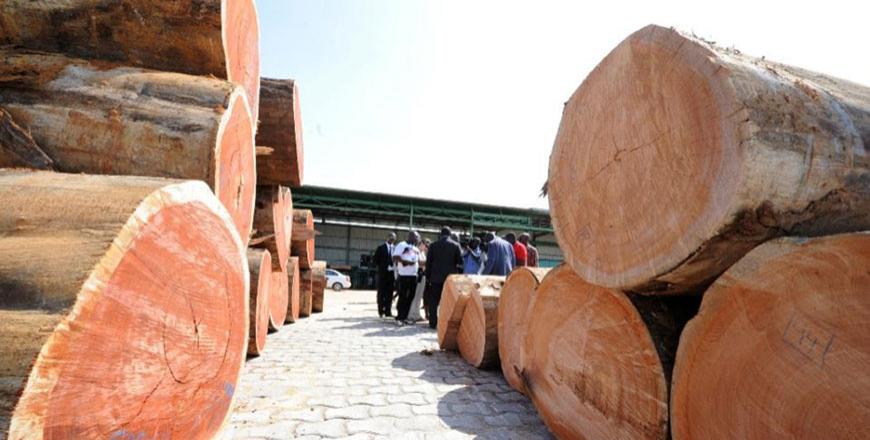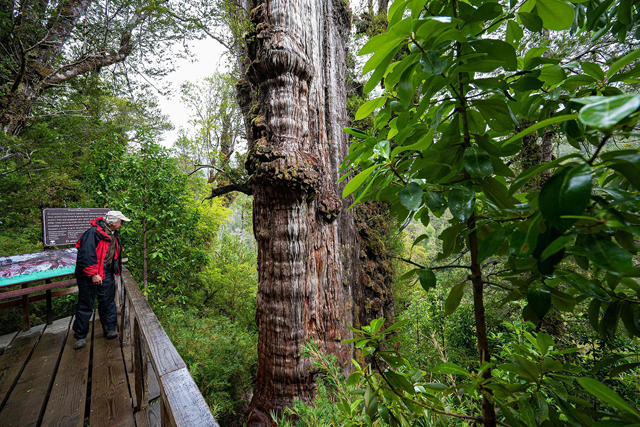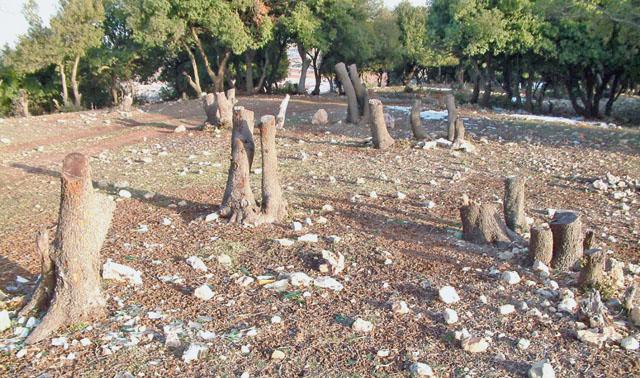You are here
A contentious quest for Kevazingo, Gabon’s sacred tree
By AFP - Jun 28,2015 - Last updated at Jun 28,2015

The hardwood of the Kevazingo tree, a famous species in Gabon, is in high demand especially in Asia and illegal logging has rocketed (AFP photo by Steve Jordan)
BITAM, Gabon — “Nobody should sell this wood. It protects the forest. But those who sell it will be hunted by the spirits of the forest,” warns Daniel Messa-Abaga, a guardian of Gabon’s Kevazingo trees.
The elderly man, born around 1930, sits on his porch at Bendoussang in the north of the densely forested equatorial country, troubled when fellow villagers sell the hardwood — sometimes from trees five centuries old — to sawmills and collectors.
Better known in the West as Bubinga, Kevazingo is much sought after in Gabon and Cameroon, but unlike the equally prized and abundant Okoume, it is rare and trees take many years to mature. They can grow more than 40 metres tall, with a trunk diameter the size of a man.
Timber from Kevazingo trees is highly valued in Asia. The Japanese and Chinese use it to make chic tables and chairs, as well as wooden bells, panels and specialty guitars, which count among export products.
The wood is hard, heavy and dense. It ranges in colour from a pinkish red through ruddy brown with streaks of black or purple. One connoisseur told AFP that “Keva” is especially appreciated for the lovely designs in the grain.
Compared with other tropical hardwoods, Kevazingo comes at an astronomical price. Cut into a single piece with sufficient girth, a single cubic metre can fetch between 1 and 2 million CFA francs (1,500-3,000 euros, $1,700-3,400) in the capital Libreville, a source close to the trade says. But on average, a cubic metre sells for 300 to 600 euros.
“The leading buyers here in Bitam are Chinese. ‘Keva’ sells according to its diameter. The price can reach 200,000 CFA francs (300 euros) here if the diameter is large,” says Jimmy Amnvene Nkounou, owner of a company in the town named “Respect du bois” (Respect For Wood).
The business is totally above board, Nkounou adds. “I acquire Kevazingo with my permit and I do so in legal fashion in the areas where I’m authorised to operate.”
He points out, however, that there can be “disputes between villages. Sometimes there are people who don’t want any logging”.
‘Substantial trafficking’
Some trees are more than 500 years old, according to Nkounou. To chop down the biggest ones, the area around each tree must first be deforested, then a ramp is dug into the soil to hold the trunk when it falls. The extremely heavy wood can then be loaded on to a lorry.
High demand for Kevazingo wood has caused the rate of illegal logging to rocket upwards, according to the non-governmental organisation Conservation, Justice, Environment, which fears the consequences. “We have seen that there is substantial trafficking,” says the NGO’s legal adviser Wilde Rosny Ngalekassaga.
Gabon banned exports of untreated lumber in 2010. Every tree chopped down should be locally processed at least once before being shipped abroad. When it comes to Kevazingo, these provisions are not always respected, according to an expert who asked not to be named.
“Today, villagers canvas for the sawmills and the chain is quite organised. At the rate we’re going, there’s a major risk that Kevazingo will disappear in the next eight to 10 years,” Ngalekassaga says.
“It really is a wild hunt. Tracks, roads are specially opened to bring down Kevazingo,” he adds, pointing out that “pretty rich pickings get away from the Gabonese state”.
Ngalekassaga acknowledges that Kevazingo does not feature on the official list of five threatened hardwood species.
“Cutting down the Kevazingo tree is not banned, but loggers must declare when they do so. They must respect the permitted diameter. This is not always the case,” he explains.
‘They thank the tree’
The ministry of water and forests says that its personnel are doing all they can to stop smuggling. “In every country in the world where forests are exploited, there is illegal logging,” says Landry Nkeyi, provincial director of the town of Oyem, an administative hub.
“When it comes to Kevazingo, yes, illegal logging takes place, but our administration moves heaven and earth to decrease the amount of chopping down in our forests. We deploy each day to cut back the exploitation, which grows ever bigger,” he adds.
“The more we think [how to catch them], the more the thieves think to get around the problem. We cooperate with NGOs and locally elected officials who help us to track down the illegal loggers,” Nkeyi says.
“Billions of CFA francs,” or millions of euros, change hands every year in the illegal logging business, according to an anonymous source familiar with the trade.
Near Oyem, a forest warden, inclines himself respectfully before a Kevazingo tree. The remains of a ritual ceremony lie between its roots, with two poles placed across the trunk.
“People come to take bark. Some pieces have therapeutic virtues,” he says. “Then they thank the tree with ceremonies like this.”
For elderly Messa-Abaga, “the generation to come after us will have difficulty understanding that this wood is important, because it might have disappeared by then. We need to preserve it.”
Related Articles
VALDIVIA, Chile — In a forest in southern Chile, a giant tree has survived for thousands of years and is in the process of being recognised
The Agriculture Ministry has doubled the number of its forest patrols to prevent illegal logging, which increases with the onset of winter, a government official said on Sunday.
Forests in Jordan make up less than 1 per cent of the country’s total area of 89,342 sq.













